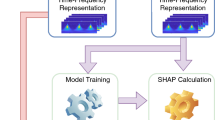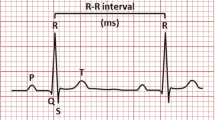Abstract
This research presents a comparison study between different representations of spectrograms and then feeding them to different convolutional neural network (CNN) architectures. The study uses two short-time Fourier transform (STFT) representations, namely, Log-scale and Mel-Scale in addition to Bi-Spectrum and the third-order cumulant. Meanwhile, four different CNN architectures have been utilized in the present study, namely, AOCT-NET, Mobile-Net, Squeeze-Net, and Shuffle-Net. The study has exploited 10,502 beats extracted from the standard MIT-BIH arrhythmia database and represent six different classes: normal beat (N), left bundle branch block beat (LBBB), right bundle branch block beat (RBBB), premature ventricular contraction (PVC), atrial premature beat (APB), and aberrated atrial premature (aAP). The study compares the accuracy, sensitivity, precision, and specificity rates of the spectrogram-based and CNN architecture models under study. This paper hypothesizes that ECG features can be extracted from different spectral representations and can lead to improving the understanding and detection of the human heart's different arrhythmias by feeding these features to different CNN models. The suggested models’ performance was evaluated by dividing the dataset into three subsets (Training 70%, Validation 15%, and Testing 15%) and the best overall performance among all used CNN architectures was MobileNet with an overall accuracy of 93.8%, while the best spectrum representation among all used was the bispectrum with an overall accuracy of 93.7%. It has been shown that the spectrum representations of ECG beat have provided significant information about heart performance and can be used significantly in arrhythmia classification using deep learning techniques.










































Similar content being viewed by others
Explore related subjects
Discover the latest articles, news and stories from top researchers in related subjects.Availability of data and materials
The dataset analyzed during the current study was derived from public domain resources.
References
Alarsan FI, Younes M (2019) Analysis and classification of heart diseases using heartbeat features and machine learning algorithms. J Big Data 6:81. https://doi.org/10.1186/s40537-019-0244-x
Al-Fahoum A, Al-Fraihat A, Al-Araida A (2014) Detection of cardiac ischaemia using bispectral analysis approach. J Med Eng Technol 38:311–316. https://doi.org/10.3109/03091902.2014.925983
Alom MZ, Taha TM, Yakopcic C, et al (2018) The history began from AlexNet: a comprehensive survey on deep learning approaches. arXiv:180301164 [cs]
Alqudah AM (2017) An enhanced method for real-time modelling of cardiac related biosignals using Gaussian mixtures. J Med Eng Technol 41:600–611. https://doi.org/10.1080/03091902.2017.1382587
Alqudah AM (2019a) Towards classifying non-segmented heart sound records using instantaneous frequency based features. J Med Eng Technol 43:418–430. https://doi.org/10.1080/03091902.2019.1688408
Alqudah AM (2019b) Ovarian cancer classification using serum proteomic profiling and wavelet features a comparison of machine learning and features selection algorithms. J Clin Eng 44:165–173. https://doi.org/10.1097/JCE.0000000000000359
Alqudah AM (2020a) AOCT-NET: a convolutional network automated classification of multiclass retinal diseases using spectral-domain optical coherence tomography images. Med Biol Eng Comput 58:41–53. https://doi.org/10.1007/s11517-019-02066-y
Alqudah AM (2020b) Brain tumor classification using deep learning technique—a comparison between cropped, uncropped, and segmented lesion images with different sizes. Int J Adv Trends Comput Sci Eng 8:3684–3691. https://doi.org/10.30534/ijatcse/2019/155862019
Alqudah A, Alqudah AM (2019) Sliding window based support vector machine system for classification of breast cancer using histopathological microscopic images. IETE J Res. https://doi.org/10.1080/03772063.2019.1583610
Alqudah AM, Albadarneh A, Abu-Qasmieh I, Alquran H (2019a) Developing of robust and high accurate ECG beat classification by combining Gaussian mixtures and wavelets features. Australas Phys Eng Sci Med 42:149–157. https://doi.org/10.1007/s13246-019-00722-z
Alqudah AM, Alquraan H, Qasmieh IA (2019b) Segmented and non-segmented skin lesions classification using transfer learning and adaptive moment learning rate technique using pretrained convolutional neural network. In: Journal of biomimetics, biomaterials and biomedical engineering. https://www.scientific.net/JBBBE.42.67. Accessed 4 Sept 2020
Alqudah A, Alqudah AM, Qazan S (2020) Lightweight deep learning for malaria parasite detection using cell-image of blood smear images. RIA 34:571–576. https://doi.org/10.18280/ria.340506
Alquran H, Alqudah AM, Abu-Qasmieh I et al (2019) ECG classification using higher order spectral estimation and deep learning techniques. Neural Netw World 29:207–219
Awang MK, Siraj F (2013) Utilization of an artificial neural network in the prediction of heart disease. Int J Bio-Sci Bio-Technol 5:159–166
Barhatte AS, Ghongade R, Thakare AS (2015) QRS complex detection and arrhythmia classification using SVM. In: 2015 Communication, Control and Intelligent Systems (CCIS), pp 239–243
Ciresan D, Meier U, Schmidhuber J (2012) Multi-column deep neural networks for image classification. 2012 IEEE conference on computer vision and pattern recognition. IEEE, Providence, pp 3642–3649
Collis WB, White PR, Hammond JK (1998) Higher-order spectra: the bispectrum and trispectrum. Mech Syst Signal Process 12:375–394. https://doi.org/10.1006/mssp.1997.0145
Deng J, Dong W, Socher R, et al (2009) ImageNet: a large-scale hierarchical image database. In: 2009 IEEE conference on computer vision and pattern recognition, pp 248–255
Dokur Z, Ölmez T (2020) Heartbeat classification by using a convolutional neural network trained with Walsh functions. Neural Comput Appl 32:12515–12534. https://doi.org/10.1007/s00521-020-04709-w
Emara T, Munim HEAE, Abbas HM (2019) LiteSeg: a novel lightweight ConvNet for semantic segmentation. In: 2019 digital image computing: techniques and applications (DICTA), pp 1–7
Fraiwan L, Lweesy K, Al-Nemrawi A et al (2011) Voiceless arabic vowels recognition using facial EMG. Med Biol Eng Comput 49:811–818. https://doi.org/10.1007/s11517-011-0751-1
Goldberger AL, Amaral LA, Glass L et al (2000) PhysioBank, PhysioToolkit, and PhysioNet: components of a new research resource for complex physiologic signals. Circulation 101:e215–e220. https://doi.org/10.1161/01.CIR.101.23.e215
Howard AG, Zhu M, Chen B, et al (2017) MobileNets: efficient convolutional neural networks for mobile vision applications. arXiv:170404861 [cs]
Huang J, Chen B, Yao B, He W (2019) ECG arrhythmia classification using STFT-based spectrogram and convolutional neural network. IEEE Access 7:92871–92880. https://doi.org/10.1109/ACCESS.2019.2928017
Iandola FN, Han S, Moskewicz MW, et al (2016) SqueezeNet: AlexNet-level accuracy with 50x fewer parameters and < 0.5 MB model size. arXiv:160207360 [cs]
Jamšek J, Stefanovska A, McClintock PV (2004) Nonlinear cardio-respiratory interactions revealed by time-phase bispectral analysis. Phys Med Biol 49:4407–4425. https://doi.org/10.1088/0031-9155/49/18/015
Jin F, Sattar F, Krishnan S (2012) Log-frequency spectrogram for respiratory sound monitoring. In: 2012 IEEE international conference on acoustics, speech and signal processing (ICASSP). IEEE, Kyoto, pp 597–600
Lin S, Cheng R, Wang K, Yang K (2018) Visual localizer: outdoor localization based on ConvNet descriptor and global optimization for visually impaired pedestrians. Sensors 18:2476. https://doi.org/10.3390/s18082476
Molau S, Pitz M, Schluter R, Ney H (2001) Computing Mel-frequency cepstral coefficients on the power spectrum. In: 2001 IEEE international conference on acoustics, speech, and signal processing. proceedings (Cat. No.01CH37221), vol 1, pp 73–76
Nordqvist C (2020) Arrhythmia: causes, symptoms, types, and treatment. https://www.medicalnewstoday.com/articles/8887. Accessed 23 Mar 2021
Nwankpa C, Ijomah W, Gachagan A, Marshall S (2018) Activation functions: comparison of trends in practice and research for deep learning. arXiv:181103378 [cs]
O’Shea K, Nash R (2015) An introduction to convolutional neural networks. arXiv:151108458 [cs]
Parthiban L, Subramanian R (2007) Intelligent heart disease prediction system using CANFIS and genetic algorithm. Int J Med Health Sci 1:278–281. https://doi.org/10.5281/zenodo.1082439
Raghavan R, Chen X, Yip K-P et al (2006) Interactions between TGF-dependent and myogenic oscillations in tubular pressure and whole kidney blood flow in both SDR and SHR. Am J Physiol Renal Physiol 290:F720–F732. https://doi.org/10.1152/ajprenal.00205.2005
Rohan D, Rohan MD, Patil DAJ (2012) Layered Approach for ECG beat classification utilizing neural network. /paper/Layered-Approach-for-ECG-beat-classification-Neural-Rohan-Rohan/1e61eaff92ce38fc1bc8143cf27d9ce4b9ca3f16. Accessed 23 Mar 2021
Russakovsky O, Deng J, Su H et al (2015) ImageNet large scale visual recognition challenge. Int J Comput Vis 115:211–252. https://doi.org/10.1007/s11263-015-0816-y
Sarkaleh MK (2012) Classification of Ecg arrhythmias using discrete wavelet transform and neural networks. IJCSEA 2:1–13. https://doi.org/10.5121/ijcsea.2012.2101
Schack B, Vath N, Petsche H et al (2002) Phase-coupling of theta–gamma EEG rhythms during short-term memory processing. Int J Psychophysiol 44:143–163. https://doi.org/10.1016/S0167-8760(01)00199-4
Schwab K, Eiselt M, Schelenz C, Witte H (2005) Time-variant parametric estimation of transient quadratic phase couplings during electroencephalographic burst activity. Methods Inf Med 44:374–383
Sejdić E, Djurović I, Jiang J (2009) Time–frequency feature representation using energy concentration: an overview of recent advances. Digital Signal Process 19:153–183. https://doi.org/10.1016/j.dsp.2007.12.004
Siu KL, Ahn JM, Ju K et al (2008) Statistical approach to quantify the presence of phase coupling using the bispectrum. IEEE Trans Biomed Eng 55:1512–1520. https://doi.org/10.1109/TBME.2007.913418
Srinivasan NT, Schilling RJ (2018) Sudden cardiac death and arrhythmias. Arrhyth Electrophysiol Rev 7:111. https://doi.org/10.15420/aer.2018:15:2
Wodey E, Tirel O, Bansard JY et al (2005) Impact of age on both BIS values and EEG bispectrum during anaesthesia with sevoflurane in children. Br J Anaesth 94:810–820. https://doi.org/10.1093/bja/aei140
Yıldırım Ö, Pławiak P, Tan R-S, Acharya UR (2018) Arrhythmia detection using deep convolutional neural network with long duration ECG signals. Comput Biol Med 102:411–420. https://doi.org/10.1016/j.compbiomed.2018.09.009
Zeng N, Zhang H, Song B et al (2018) Facial expression recognition via learning deep sparse autoencoders. Neurocomputing 273:643–649. https://doi.org/10.1016/j.neucom.2017.08.043
Zeng N, Wang Z, Zhang H et al (2019) An improved particle filter with a novel hybrid proposal distribution for quantitative analysis of gold immunochromatographic strips. IEEE Trans Nanotechnol 18:819–829. https://doi.org/10.1109/TNANO.2019.2932271
Zeng N, Li H, Wang Z et al (2021) Deep-reinforcement-learning-based images segmentation for quantitative analysis of gold immunochromatographic strip. Neurocomputing 425:173–180. https://doi.org/10.1016/j.neucom.2020.04.001
Zhang X, Zhou X, Lin M, Sun J (2018) ShuffleNet: an extremely efficient convolutional neural network for mobile devices. In: 2018 IEEE/CVF conference on computer vision and pattern recognition. IEEE, Salt Lake City, pp 6848–6856
Author information
Authors and Affiliations
Contributions
All authors have contributed equally to this work.
Corresponding author
Ethics declarations
Conflict of interest
The authors declare no conflict of interest.
Ethical approval
This article does not contain any studies with human participants or animals performed by any of the authors.
Rights and permissions
About this article
Cite this article
Alqudah, A.M., Qazan, S., Al-Ebbini, L. et al. ECG heartbeat arrhythmias classification: a comparison study between different types of spectrum representation and convolutional neural networks architectures. J Ambient Intell Human Comput 13, 4877–4907 (2022). https://doi.org/10.1007/s12652-021-03247-0
Received:
Accepted:
Published:
Issue Date:
DOI: https://doi.org/10.1007/s12652-021-03247-0




